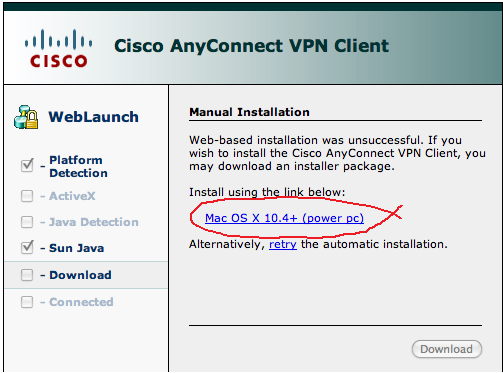Download AnyConnect. Double click on the Cisco AnyConnect software icon. Adobe acrobat pro dc 2019 mac os catalina. (If using Windows 8/8.1, from the Start screen, tap or click the Desktop tile, then tap or click the Libraries icon in the Navigation pane. Tap or click Downloads, then double-click on the Cisco AnyConnect software icon.); Click on Next on the Welcome screen.; Click on the bubble beside I accept the terms in the License. Follow the instructions below to download, install and connect the AnyConnect Secure Mobility Client on your Windows computer to the VPN. Open Cisco AnyConnect Secure Mobility Client. The app can be found by clicking the small white up arrow in desktop tray and then clicking Cisco AnyConnect globe.
Overview
Stanford's VPN allows you to connect to Stanford's network as if you were on campus, making access to restricted services possible. To connect to the VPN from your Windows computer you need to install the Cisco AnyConnect VPN client.
A simple python code that convert your evernote to notion.so with all the images displayed. Python = 3.6.0 (Only for f-strings, which can be modified in earlier Python versions.) requirements.txt; Installation. Install Python and pip. Git clone or download this repo. Open cmd/terminal and install required packages. I have switched from Evernote to Notion, but there are a few things I’ll miss about Evernote. However, it wasn’t enough to prevent me from switching to this. Comparing Notion and Evernote’s features You can think of Notion as a high-performing sportscar and Evernote as a serviceable Jetta. Both work well, and the right car will be influenced by your style of driving. Here’s a table comparing the two products’ feature sets. Evernote to notion. Notion and Evernote are two very different tools with very similar goals. The biggest difference between the two products is that, as an all-in-one workspace tool, Notion helps users keep all their work in one place. As an organizational note-taking tool, Evernote helps users keep their files in one place.
Two types of VPN are available:
:no_upscale()/cdn.vox-cdn.com/uploads/chorus_asset/file/13208165/androidwindows10.JPG)
- Default Stanford (split-tunnel). When using Stanford's VPN from home, we generally recommend using the Default Stanford split-tunnel VPN. This routes and encrypts all traffic going to Stanford sites and systems through the Stanford network as if you were on campus. All non-Stanford traffic proceeds to its destination directly.
- Full Traffic (non-split-tunnel). This encrypts all internet traffic from your computer but may inadvertently block you from using resources on your local network, such as a networked printer at home. If you are traveling or using wi-fi in an untrusted location like a coffee shop or hotel, you may wish to encrypt all of your internet traffic through the Full Traffic non-split-tunnel VPN to provide an additional layer of security.

You can select the type of VPN you want to use each time you connect to the Stanford Public VPN.
Download Cisco Anyconnect Vpn For Windows 8
Install the VPN client
- Download the Cisco AnyConnect VPN for Windows installer.
- Double-click the InstallAnyConnect.exe file.
- When a message saying the Cisco AnyConnect client has been installed, click OK.
Connect to the Stanford VPN
- Launch the Cisco AnyConnect Secure Mobility Client client.
If you don't see Cisco AnyConnect Secure Mobility Client in the list of programs, navigate to Cisco > Cisco AnyConnect Secure Mobility Client. - When prompted for a VPN, enter su-vpn.stanford.edu and then click Connect.
- Enter the following information and then click OK:
- Group: select Default Stanford split- tunnel (non-Stanford traffic flows normally on an unencrypted internet connection) or Full Traffic non-split-tunnel (all internet traffic flows through the VPN connection)
- Username: your SUNet ID
- Password: your SUNet ID password
- Next, the prompt for two-step authentication displays. Enter a passcode or enter the number that corresponds to another option(in this example, enter 1 to authenticate using Duo Push to an iPad). Then click Continue.
- You may have to scroll down the list to see all of your options.
- If your only registered authentication method is printed list, hardware token, or Google Authenticator, the menu does not display. Enter a passcode in the Answer field and click Continue.
- Click Accept to connect to the Stanford Public VPN service.
- Once the VPN connection is established, a message displays in the lower-right corner of your screen, informing you that you are now connected to the VPN.
Disconnect from the Stanford VPN
Download Cisco Anyconnect Vpn For Windows 7
- In the notification area, click the Cisco AnyConnect icon if it is displayed. Otherwise, go to your list of programs and click Cisco AnyConnect Secure Mobility Client.
- At the prompt, click Disconnect.
